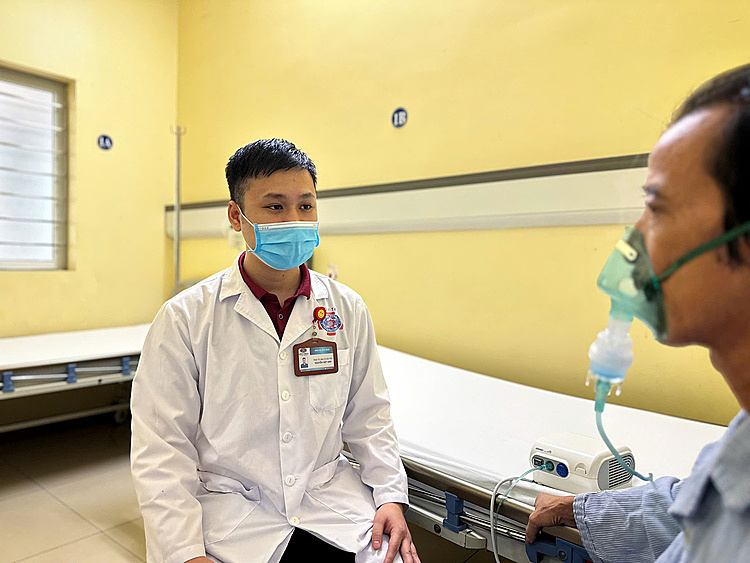A year ago, a woman in Hung Yen was diagnosed with stage two breast cancer. Her tumor measured about 2.5 cm, and doctors recommended chemotherapy combined with targeted therapy before surgery (neoadjuvant chemotherapy) to shrink the tumor. After the first infusion, she experienced severe pain, hair loss, loss of appetite, nausea, and pallor. Believing that further chemotherapy would worsen her already weakened state, she opted for traditional herbal remedies, despite her family's pleas.
Several months later, the tumor had grown eight times its original size, becoming taut, bursting with foul-smelling yellow fluid, and bleeding uncontrollably. Dr. Nguyen Viet Anh, former doctor of the Thoracic Radiation Oncology Department at K Hospital, now Head of the Oncology Department at Viet Duc General Hospital, stated that immediate intervention was no longer possible and the prognosis was grim.
Anh Kien, a 58-year-old carpenter from Phu Tho, diagnosed with stage two esophageal cancer, also abandoned his chemoradiotherapy regimen due to fear. He had witnessed a fellow villager suffer through chemotherapy, experiencing pain, hair loss, and severe weight loss before ultimately succumbing to the disease. This led him to believe that "treatment only prolongs suffering and doesn't save anyone". After much deliberation, he decided to discontinue treatment and sought relief through traditional herbal remedies.
A few months later, he experienced difficulty swallowing, became unable to eat, and lost nearly 10 kg. Excruciating chest pains forced him to return to the hospital, where doctors revealed that the tumor had invaded his trachea, making treatment difficult and the prognosis grave.
 |
A doctor treating a patient. Photo: Thuy Quynh |
A doctor treating a patient. Photo: Thuy Quynh
Chemotherapy uses drugs to destroy or inhibit the growth of cancer cells. These drugs can be administered via injection, orally, or intravenously. They work by targeting rapidly dividing cells. While effective against cancer cells, chemotherapy also affects healthy cells, causing side effects such as fatigue, hair loss, weakness, loss of taste, nausea, fever, mouth sores, anemia, and elevated liver enzymes. These side effects typically appear 7-14 days after treatment.
While there are no precise statistics on the number of patients who abandon cancer treatment, the phenomenon of patients refusing treatment due to fear of chemotherapy is widespread. Dr. Viet Anh attributes this to a "double shock": patients, still reeling from the initial cancer diagnosis, are then confronted with the fear of pain, hair loss, and physical changes brought on by chemotherapy. These changes can sometimes lead to feelings of shame and stigma, further discouraging patients and leading them to abandon treatment, ultimately forfeiting their chance of survival.
Furthermore, some older chemotherapy drugs had high toxicity, and treatment regimens were not as personalized as they are today. Stories and memories of patients suffering from extreme exhaustion, incessant vomiting, and death after chemotherapy have solidified the persistent belief that chemotherapy is "poison".
However, doctors emphasize that the notion of "chemotherapy killing patients" is scientifically inaccurate. Chemotherapy, along with surgery and radiation therapy, remains one of the three main pillars of cancer treatment, extending the lives of millions. Data from organizations like the American Cancer Society (ACS) and the National Cancer Institute (NCI) show that overall survival rates for many cancers have increased significantly thanks to the combination of advanced therapies and chemotherapy. For example, the 5-year survival rate for breast cancer has risen from about 75% in the 1970s to nearly 90% today, thanks in large part to adjuvant chemotherapy. For Hodgkin lymphoma, the cure rate in children and young adults now exceeds 90%, with chemotherapy as the primary treatment.
Modern science has made strides in managing and mitigating the risks of chemotherapy, transforming it from a feared therapy into a safer and more effective treatment tool. Supportive care is now standardized, focusing on addressing severe side effects.
Specifically, to combat nausea and vomiting—a major concern for patients—doctors use new-generation antiemetics (such as 5-HT3 and NK1 receptor antagonists) with high efficacy. For neutropenia caused by bone marrow suppression, which increases the risk of life-threatening infections, medicine has adopted growth factors, typically G-CSF, to promote rapid bone marrow recovery and significantly reduce the risk of infectious complications. Additionally, risks of cardiac or renal toxicity are closely monitored through regular testing and imaging.
"This allows experts to personalize drug dosages or switch to less toxic chemotherapy drugs, protecting the patient's vital organs," Dr. Anh explained.
Vietnam faces a significant cancer burden. An estimated 350,000 Vietnamese people are currently living with cancer, with over 165,000 new cases and 115,000 deaths each year. According to the World Health Organization (WHO), for every 100,000 Vietnamese people, 159 are diagnosed with cancer and 106 die from it, placing Vietnam's cancer mortality rate in the top 50 among 185 countries.
Doctors recommend maintaining a healthy lifestyle and encourage those over 40 to undergo early cancer screening. "Especially when the disease is detected, following conventional medical treatment is the only way. It's crucial to avoid misconceptions and anecdotal treatment methods lacking scientific basis," Dr. Viet Anh emphasized.
Thuy Quynh












